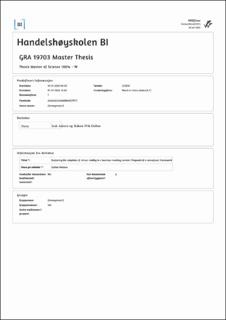| dc.description.abstract | This study explores the relatively novel topic of virtual reality (VR) technology in
the context of business meetings. Accelerated by the COVID-19 pandemic,
businesses have increasingly opened up for remote work, and digital acceleration
has climbed its way to the top of the agenda for many corporations. During the past
years, there has been a sharp rise in the use of alternative meeting formats such as
Zoom and Microsoft Teams. Fuelled by tech giants such as Meta and Microsoft,
companies are increasingly also looking into the prospects of VR and augmented
reality (AR).
In two studies, we investigate the determinants for behavioural intent to adopt VR
in business and compare the perceived meeting quality (PMQ) of meetings in VR,
Zoom and face-to-face (F2F). Study 1 is a questionnaire (n = 194) assessing barriers
to VR in business and the behavioural intent to adopt VR in the Scandinavian
market. This study reveals that VR is perceived as more engaging, interactive, and
fun than traditional videoconferencing in Zoom or Teams. On the other hand, the
results show a consensus that VR is not fully ready for adoption in the Scandinavian
mass-market just yet. Study 2 extends these results through a lab experiment (n =
90) with a 3 (communication mode: VR vs. Zoom vs. face-to-face) x 2 (type of
meeting: problem-solving vs. team building) mixed design. The study shows that
VR is a superior communication mode to Zoom, and that no significant difference
exists between VR and F2F meetings overall. With the only exception being
problem-solving meetings, where the perceived meeting quality was slightly higher
in F2F than in VR.
The findings of our research have important implications for future research on
adoption of VR technology in business, and on managerial decisions for future
virtual collaboration. Based on our own research and past studies on technology
adoption, we propose a conceptual framework for future researchers and businesses
to leverage when investigating the adoption of VR in organizations. In addition, we
introduce “the 9Cs”, a model designed to assist managers in making the right
choices for VR adoption in their business. In sum, our studies demonstrate that the
current VR technology has already surpassed traditional videoconferencing as a
more engaging, fun, and interactive communication mode. Moreover, in line with
media naturalness theory (MNT), we find evidence that VR as a communication
mode to a large extent resembles F2F communication, and therefore feels more
natural and less dependent on cognitive effort from the participants. | en_US |
